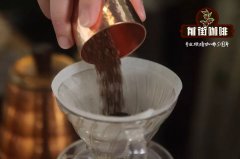Coffee brewing suggestion of Gable Manor in Tara Zhu, Costa Rica _ description of Coffee Bean Flavor of Gable Manor

Professional coffee knowledge exchange more coffee bean information please follow the coffee workshop (Wechat official account cafe_style)
Costa Rican Coffee Gable Manor
Baking in black honey treatment
Taste spectrum: longan sweet honey fragrance smooth and mellow
Origin: Costa Rican Coffee Tarazhugaibo Manor Diamond Hill processing Plant
Features: Costa Rica is the birthplace of honey processing, while the difficult and high-quality black honey treatment is processed by only a few experienced processing plants. The 75-year-old Diamond Hill processing plant at Gabriel Manor is one of them, with an annual output of only 500 sacks.
Allen drank a black honey-treated coffee from Gabriel Manor in Costa Rica. The first reaction at that time was: yes. The second reaction is: Costa Rica?
This is the feeling. In fact, Allen tasted it on the cup test table. The card clearly says Costa Rica, and you can clearly see it before drinking it, but when the taste spreads in your mouth, you really have no way to define Costa Rican coffee with your impression of Costa Rican coffee a long time ago.
In fact, the reason for the flavor change is very simple, because after the real contact with boutique coffee, Allen has never officially tasted a coffee bean from Costa Rica. It does not have the acid that can be caught at a glance like African beans, nor does it emit unique characteristics like coffee beans in the Asia-Pacific region. It is easy to forget, but also happens to be such a flavor, the sudden emergence of a unique flavor, can make you remember deeply. It's like a colleague who never talks, suddenly bought you a delicious cake one day.
When it comes to the development of Costa Rican coffee, you will first think of "government", followed by "honey treatment".
Government: this is synonymous with Costa Rican coffee before 1950. The government has taken coffee control to the extreme. Leaving aside the export control, it is said that even the seeds are distributed by the government to farmers. And if a farmer grows coffee on a piece of uncultivated land for five years, the land belongs to the farmer. You can imagine that in China, the state gives you rice seeds, you find a random piece of land, plant rice for five years, and then the land belongs to you. Oh, my God, I can't think of it.
With such strong control and support, Costa Rican coffee has always had a good evaluation in the international market. The flavor of coffee beans treated by water washing is also cleaner. But officially, such praise has led farmers to try to give up planting native species and plant higher-yielding hybrids, which has led to a decline in the quality of coffee.
Then, in the middle of the 20th century, more and more micro-farmers began to grow different varieties of coffee, and adopted different treatments to make the flavor of coffee more special. This kind of coffee gets better evaluation in the boutique market, so there are more micro-farms, so we can drink more different high-quality coffee.
Honey treatment: the most common word we have heard about Costa Rican coffee in recent years is honey treatment. The honey treatment of various colors makes Costa Rican coffee come into the sight of more people. Most of the more unique treatments mentioned above refer to these honey treatments.
END
Important Notice :
前街咖啡 FrontStreet Coffee has moved to new addredd:
FrontStreet Coffee Address: 315,Donghua East Road,GuangZhou
Tel:020 38364473
- Prev

Costa Rica Peak Manor Black Honey Coffee Hand Brewing Share_Peak Manor Coffee Flavor Features
Professional coffee knowledge exchange More coffee bean information Please pay attention to coffee workshop (Weixin Official Accounts cafe_style) Cadura from Costa Rica-Summit Manor, treated with red honey, presents the refreshing sour and sweet taste of melon and green apple and velvety silky taste Costa Rica-Summit Manor: This bean is treated with black honey, with caramel, grapefruit and red
- Next

Costa Rican Carnett Manor Coffee Bean hand-brewing parameters Costa Rican Honey treatment Story
For more information on coffee beans, please refer to Coffee Workshop (Wechat official account cafe_style) COSTA RICA CANET Yellow Catuai Carnett Manor Huang Cadura 01 | production profile Carnett Manor Canet is located in the highest altitude area where coffee is grown in Tarrazu Tarazu, Costa Rica. Carnett is a small farm in this field.
Related
- Detailed explanation of Jadeite planting Land in Panamanian Jadeite Manor introduction to the grading system of Jadeite competitive bidding, Red bid, Green bid and Rose Summer
- Story of Coffee planting in Brenka region of Costa Rica Stonehenge Manor anaerobic heavy honey treatment of flavor mouth
- What's on the barrel of Blue Mountain Coffee beans?
- Can American coffee also pull flowers? How to use hot American style to pull out a good-looking pattern?
- Can you make a cold extract with coffee beans? What is the right proportion for cold-extracted coffee formula?
- Indonesian PWN Gold Mandrine Coffee Origin Features Flavor How to Chong? Mandolin coffee is American.
- A brief introduction to the flavor characteristics of Brazilian yellow bourbon coffee beans
- What is the effect of different water quality on the flavor of cold-extracted coffee? What kind of water is best for brewing coffee?
- Why do you think of Rose Summer whenever you mention Panamanian coffee?
- Introduction to the characteristics of authentic blue mountain coffee bean producing areas? What is the CIB Coffee Authority in Jamaica?

